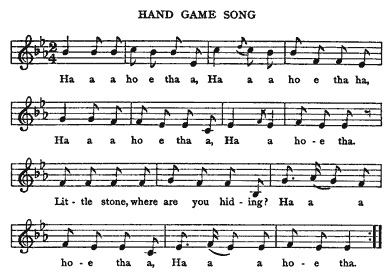Indian Guessing Games
by Alice C. Fletcher
III. Hand Game
INTRODUCTORY NOTE.—This game, Dr. Culin states, is played among eighty-one Indian tribes of the United States. The game bears different names in the various languages of these tribes. Hand Game is a descriptive term and not a translation of any native name; it refers to the fact that the object is held in the hand during the play. The following form of this game is the way it was formerly played among the Nez Perce Indians of the State of Idaho. Lewis and Clark, who were the first white men to record their meeting with these Indians, mention this game, and Capt. Bonneville gives an account of it when he visited the tribe during the third decade of the last century.
Properties.—A bone or wooden bead about two inches in length and half an inch in thickness; thirty counting sticks (these are sometimes spoken of as arrows, and there are indications that they were once arrows—the arrows of the twin gods); a mat oblong in shape; two logs or pieces of board about the length of the mat, and as many sticks (to be used as drum-sticks) as players can sit on one side of the mat.
Directions.—The mat should be laid east and west, the logs or boards put on the north and south edges and the counting sticks placed in two piles of fifteen each on the ends of the mat. The players sit on the ground, a row on each side of the mat to the north and south. Lots are drawn to decide which side shall have the bead "in hand." The Leader and the singers must always stand behind the row of players who have the bead "in hand." The opposite side must have the drum-sticks and beat on the log or board in time with the singers.
When the players are seated in two rows, one on each side of the mat, the Leader hands the bead to a player on the side that has drawn the right to have the bead "in hand," and then takes his place beside the singers, who stand behind that row, and starts the following song. All in that row join in the singing.
Hand Game Song

The players on the opposite side, who are to guess who is hiding the bead, at once begin to beat the time of the song on the log or board that is in front of them, on the edge of the mat, and at the same time they must watch the other side where the players are trying to pass the bead from one hand to the other and from one person to another without exposing the bead to view. In all these actions the movements of hands, arms and body must be rhythmical and in time with the song. All the players in the row that has the bead "in hand" must act as if each one either had the bead or was trying to pass it on, whether he actually has the bead or does not have it.
When one on the opposite side thinks he detects the whereabouts of the bead and is willing to risk a guess, he points his drum-stick to the hand he thinks has the bead and cries, "Hi-i!" and the hand indicated must be immediately opened so that all may see whether the guess is correct or not. If the bead is seen to be in the opened hand, the Leader calls out, "Success!" and goes to the pile of counting sticks belonging to the side of the guesser, takes one and stands it in the ground in front of the successful guesser. The Leader then hands the bead to the player who has won and proceeds to gather the drum-sticks and distribute them to the players on the opposite side. The singers pass around and take their places behind the row of players who now have the bead "in hand." When all are in readiness, the Leader starts the song again and the players begin their movements of secretly passing the bead, while the other side beat time with their drum-sticks on the log or board in front of them. The side that has the bead "in hand" always does the singing, led by the Leader and singers, who must stand at the rear of the row having the bead.
If a guess is incorrect the Leader goes to the pile of counting sticks that belongs to the side which has the drum-sticks, takes a counting stick and thrusts it in the ground in front of the row opposite to the guesser; that means one lost to his side. The bead in that instance remains on the same side until it is won by the opposite side through a successful guess.
In this manner the game goes on until one side or the other has won all the thirty counting sticks and become the victor in the game.